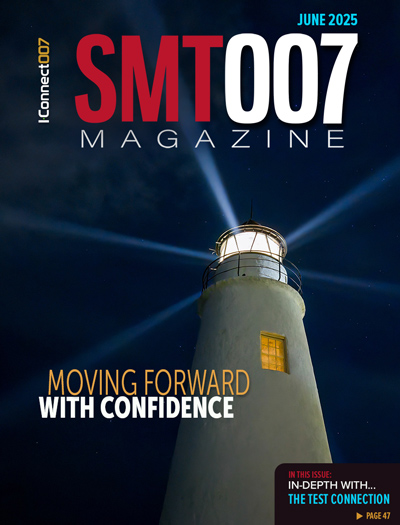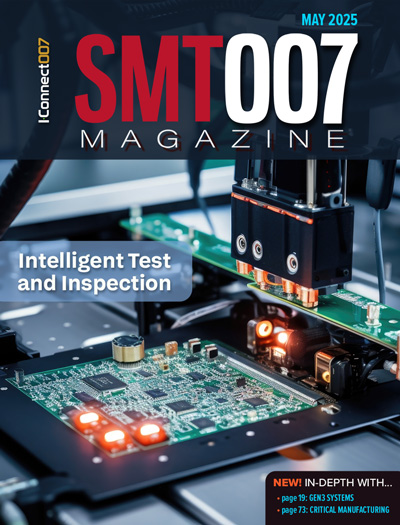-

-
News
News Highlights
- Books
Featured Books
- smt007 Magazine
Latest Issues
Current Issue
What's Your Sweet Spot?
Are you in a niche that’s growing or shrinking? Is it time to reassess and refocus? We spotlight companies thriving by redefining or reinforcing their niche. What are their insights?

Moving Forward With Confidence
In this issue, we focus on sales and quoting, workforce training, new IPC leadership in the U.S. and Canada, the effects of tariffs, CFX standards, and much more—all designed to provide perspective as you move through the cloud bank of today's shifting economic market.

Intelligent Test and Inspection
Are you ready to explore the cutting-edge advancements shaping the electronics manufacturing industry? The May 2025 issue of SMT007 Magazine is packed with insights, innovations, and expert perspectives that you won’t want to miss.
- Articles
- Columns
- Links
- Media kit
||| MENU - smt007 Magazine
Teledyne’s New High-resolution Multispectral Line Scan Camera Extends Defect Detection Beyond the Surface
April 5, 2022 | Globe NewswireEstimated reading time: 1 minute
Teledyne DALSA, a Teledyne Technologies company, is pleased to announce the release of its multispectral Camera Link HS (CLHS) line scan camera—a new model of the award-winning Linea product line. This latest high resolution line scan camera provides spectrally independent RGB and NIR outputs making it uniquely capable of handling some of the most challenging inspection applications by detecting defects both on and under the surface of a wide variety of materials, components, and products.
“The Linea ML 8k multispectral camera offers versatile capabilities to meet the increasingly demanding requirements of a number of today’s challenging inspection applications, like banknotes, passports, and other high security print,” said Xing-Fei He, Senior Product Manager at Teledyne DALSA. “In addition, we have been able to deliver spectrally independent outputs of the RGB and NIR channels which enables accurate defect detection both on and under the surface of products like semiconductor wafers and printed circuit boards (PCBs) in a single scan, greatly simplifying vision system designs.”
The Linea ML 8k multispectral camera uses Teledyne DALSA’s latest CMOS 8k quad linear sensor with a 5x5 ?m pixel size and delivers a maximum line rate of 70 kHz x 4 using CLHS fibreoptic interface. The camera also has built-in SFP+ transceivers that convert electrical signals to optical signals and connects directly to fibreoptic cables using LC connectors. Combined with the Teledyne DALSA Xtium™2 CLHS series of high-performance frame grabbers, the Linea ML 8k multispectral camera, like all of the Linea ML cameras, represent a breakthrough in data throughput in the industry.
Key Features:
- Teledyne DALSA’s newest CMOS quadlinear sensor
- Spectrally independent RGB and NIR outputs for accurate detection of defects without spectral interference
- Independent exposure control for each channel for better white balancing
- Works seamlessly from max speed to stop conditions
- Next generation Camera Link HS interface with field-proven data reliability
- Direct connection to fibreoptic cables for extended cable lengths up to 300 meters
Suggested Items
Boeing, Angolan Ministry of Transport Sign Memorandum of Strategic Cooperation
06/21/2025 | BoeingBoeing and the Ministry of Transport of the Republic of Angola signed a Memorandum of Strategic Cooperation to explore initiatives aimed at advancing the Angolan aviation sector, in partnership with TAAG Angola Airlines.
Day 2: More Cutting-edge Insights at the EIPC Summer Conference
06/18/2025 | Pete Starkey, I-Connect007The European Institute for the PCB Community (EIPC) summer conference took place this year in Edinburgh, Scotland, June 3-4. This is the third of three articles on the conference. The other two cover Day 1’s sessions and the opening keynote speech. Below is a recap of the second day’s sessions.
Elementary, Mr. Watson: PCB Routing: The Art—and Science—of Connection
06/11/2025 | John Watson -- Column: Elementary, Mr. WatsonMany people who design circuit boards love the routing part of the design. This is partially because we want to stop looking at the annoying rat's nest of connections, which seem to have no rhyme or reason at first glance. We want to get to something more exciting. Routing is the ultimate part of solving the puzzle. You take all the messy lines from the schematic and turn them into neat, organized paths.
Tariff Effects and China Subsidies Soften 1Q25 Downturn; Foundry Revenue Decline Narrows to 5.4%
06/09/2025 | TrendForceTrendForce’s latest investigations find that the global foundry industry recorded 1Q25 revenue of US$36.4 billion—a 5.4% QoQ decline. The downturn was softened by last-minute rush orders from clients ahead of the U.S. reciprocal tariff exemption deadline, as well as continued momentum from China’s 2024 consumer subsidy program.
KYZEN Focuses on Aqueous Cleaning and Stencil Cleaning at SMTA Ontario
06/09/2025 | KYZEN'KYZEN, the global leader in innovative environmentally responsible cleaning chemistries, will exhibit at the SMTA Ontario Expo and Tech Forum, scheduled to take place Tuesday, June 17 at the Venu Event Space in Vaughan, Ontario, Canada. KYZEN will be on-site to provide information about aqueous cleaning chemistry AQUANOX A4618 and the full line of AQUANOX products.


